At present there is a huge debate regarding the validity to the claims that Orville and Wilbur Wright were the first to fly a “heavier than air craft”. StrangeHistory.org has uncovered this article written by the editor of the Bridgeport Sunday Herald, Bridgeport Connecticut. The article is dated August 18, 1901, two years and four months before the Wright Brother’s historic flight at Kitty Hawk, North Carolina.
Bridgeport Sunday Herald, Aug. 18, 1901
FLYING
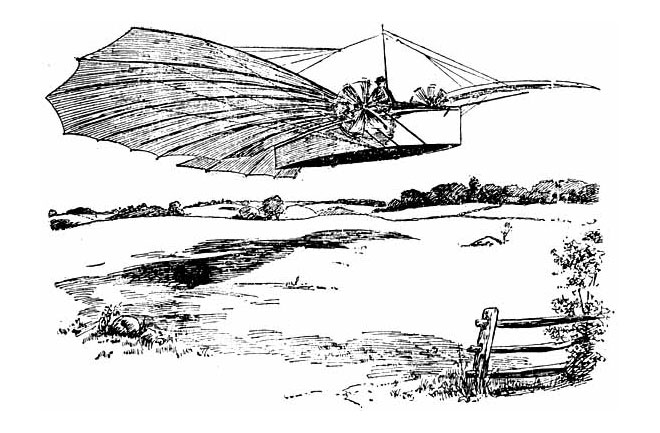 “The success that has attended the experiments of the young Brazilian M. Santos-Dumont in scientific ballooning in France has been responsible for a marked impetus in this country in the fascinating and daring sport of flying. The probability is, however, that the final solution of successfully navigating the air by two American inventors combining their brains and energies toward perfecting a flying machine that will do what scores of men have been working to accomplish for many years.
“The success that has attended the experiments of the young Brazilian M. Santos-Dumont in scientific ballooning in France has been responsible for a marked impetus in this country in the fascinating and daring sport of flying. The probability is, however, that the final solution of successfully navigating the air by two American inventors combining their brains and energies toward perfecting a flying machine that will do what scores of men have been working to accomplish for many years.
Gustave Whitehead of Bridgeport and W. D. Custead of Waco, Texas have co-operated and are now working on a flying machine which is expected to revolutionize the world of aeronautics. Accompanying this article are pictures of both the Custead and Whitehead flying machines. Mr. Whitehead is employed at
the Wilmot & Hobbs works as night watchman, and during during about half the time that is allotted to most men to sleep he is working on his flying machine. Some weeks ago Mr. Whitehead took his machine out beyond Fairfield in a large field and tried it.
There was no doubt of it being able to fly at that time the inventor did feel like raising himself for a trial.
Tuesday night, however of the last week, Mr. Whitehead, Andrew Cellie, and James Dickie, his two partners in the flying machine and a representative of the Herald left the little shed on Pine street where the machine is housed and took it to a suitable spot beyond Fairfield where its inventor had planned to take his first flight.
The start was made shortly after midnight in order to not attract attention. The wings or propellers were folded tightly to the sides of the body of the air ship. The two engines were carefully tried before starting out and now the acetylene generator was gone over a last time by Mr. Whitehead to see that it was in perfect order. There was only room for two in the machine, Whitehead and Cellie occupying the seats while James Dickie and the Herald representative followed on bicycles.
The machine rolls along the ground on small wooden wheels, only a foot in diameter, and, owing to their being so small, the obstructions in the road made it rock from on side to the other in an alarming fashion at times when the speed was fast. After reaching the Protestant Orphan asylum at the corner of Fairfield avenue and Ellsworth street there is a clear stretch of macadam road the the flying automobile was sent spinning along the road at the rate of twenty miles an hour. For short distances from then on the speed was close to thirty miles but as the road was not straight or level for any distance this rate of speed could not be maintained. There seems no doubt that the machine, even with its present common board wheels of only a foot in diameter, can reel off forty miles an hour and not exert the engine to its fullest capacity.
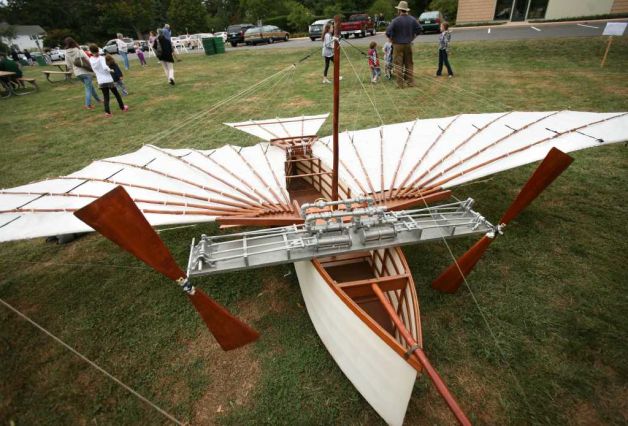
A one half scale model of Gustave Whitehead's Number 21, the plane he reportedly flew over Fairfield on the morning of August 14, 1901
The location selected to fly the machine was back of Fairfield along the highway where there is a large field and few trees to avoid in flying the air ship.
It was about 2 o’clock Wednesday morning when the great white wings of the air ship were spread out ready to leap through the air. Mr. Whitehead was excited and enthusiastic and his two partners were almost as bad. The light was not very strong and everything looked like a ghost. Whitehead spoke in whispers, although the reason for it was not apparent. But probably the very time selected for trying the machine was responsible for that. The Herald representative assisted when the opportunity afforded, but a stranger about a flying machine is sadly out of place and absolutely in the way when it comes to the hour to fly the ship. Ropes were attached to the ship so that she would not get away from her handlers. In the body of the machine were two bags of sand, each weighing about 110 pounds, for ballast. Mr. Whitehead started the engine that propels the machine along the ground on the four wooden wheels, while his two assistants clung to the safety ropes. The newspaper man kept well clear of the machine, partly to better watch the operations and partly not to get tangled up in the ropes and wings of the giant white bat. Slowly the machine started at first to run over the ground, but inside of a hundred yards the men who had hold of the ropes and inventor Whitehead were running as fast as their legs would travel. Then Whitehead pulled open the throttle that starts the air propellers or wings and shut off the ground propelling engine. Almost instantly the bow of the machine lifted and she raised at an angle of about six degrees. The great white wings were working beautifully. She looked for all the world like a great white goose raising from the feeding ground in the early morning dawn. The two men with the ropes were tumbling over the hummocks in the field for it was not clear enough yet to avoid such obstructions readily, and Whitehead waved his hands enthusiastically and excitedly as he watched his invention rise in the air. He had set the dial so that the power would shut off automatically when it had made one revolution in order that the machine would not keep flying and smash against the trees at the other end of the field. When the power was shut the air ship settled as lightly on the ground as a bird and not a stitch was broken or a rod bent.
The air ship was now taken back to the starting point. And now the real test was to be made. Whitehead had determined to fly in the machine himself. She had behaved so nicely that he felt that there would no longer be any trouble about his flying in the place of the 220 pounds of sand that was used for the ballast on the first trip.
The engines were carefully tested again and every joint and rod in the structure was carefully gone over and critically inspected. The bags of sand were taken out of the machine.
By this time the light was good. Faint traces of the rising sun began to suggest themselves in the east. An early morning milkman stopped in the road to see what was going on. His horse nearly ran away when the big white wings flapped to see if they were all right.
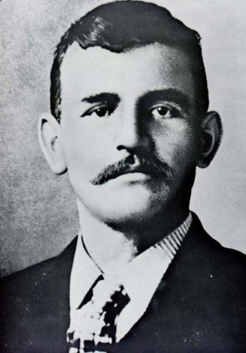
Gustave Whitehead
The nervous tension was growing at every clock tick and no one showed it more than Whitehead who still whispered at times but as the light grew stronger began to speak in his normal tone of voice. He stationed his two assistants behind the machine with instructions to hold on to the ropes and Not let the machine get away. Then he took up his position in the great bird. He opened the throttle of the ground propeller and shot along the green at a rapid rate."I’m going to start the wings!" he yelled. "Hold her now." The two assistants held on the best they could but the ship shot up in the air almost like a kite. It was an exciting moment.
"We can’t hold her!" shrieked one of the rope men.
"Let go then!" shouted Whitehead back. They let go and as they did so the machine darted up through the air like a bird released from a cage. Whitehead was greatly excited and his hands flew from one part of the machine to another. The newspaper man and the two assistants stood still for a moment watching the air ship in amazement. Then they rushed down the sloping grade after the air ship. She was flying now about fifty feet above the ground and made a noise very much like the "chug, chug, chug," of an elevator going down the shaft.
Whitehead had grown calmer now and seemed to be enjoying the exhilaration of the novelty. He was headed straight for a clump of chestnut sprouts that grew on a high knoll. He was now about forty feet in the air and would have been high enough to escape the sprouts had they not been on a high ridge. He saw the danger ahead and when within two hundred yards of the sprouts made several attempts to manipulate the machinery so he could steer around, but the ship kept steadily on her course, head on for the trees. To strike them meant wrecking the air ship and very likely death or broken bones for the daring aeronaut.
Here it was that Whitehead showed how to utilize a common sense principle which he had noticed the birds make use of thousands of times when he had been studying them in their flight for points to make his air ship a success. He simply shifted his weight more to one side than the other. This careened the ship to one side. She turned her nose away from the clump ofsprouts when within fifty yards of them and took her course around them asprettily as a yacht on the sea avoids a bar. The ability to control the air ship in this manner appeared to give Whitehead confidence, for he was seen to take time to look at the landscape about him. He looked back and waved his hand exclaiming, "I’ve got it at last."
He had now soared through the air for fully half a mile and as the field ended a short distance ahead the aeronaut shut off the power and prepared to light. He appeared to be a little fearful that the machine would dip ahead or tip back when the power was shut off but there was no sign of any such move on the part of the big bird. She settled down from a height of about fifty feet in two minutes after the propellers stopped. And she lighted on the ground on her four wooden wheels so lightly that Whitehead was not jarred in the least.
How the inventors face beamed with joy! His partners threw their arms around his neck and patted him on the back and asked him to describe his feelings while he was flying.
"I told you it would be a success," was all he could say for some time. He was like a man who is exhausted after passing through a severe ordeal. And this had been a severe ordeal to him. For months, yes years he had been looking forward to this time, when he would fly like a bird through the air by means that he had studied with his own brain. He was exhausted and he sat down on the green grass beside the fence and looked away where the sun’s first rays of light were shooting above the gray shrouding fog that nestled on the bosom of Long Island Sound.
Gods, what a picture for a painter of "Hopes Recalled at Dawn." And there he sat in silence thinking. His two faithful partners and the Herald reporter respected his mood and let him speak the first words.
"It’s a funny sensation to fly."
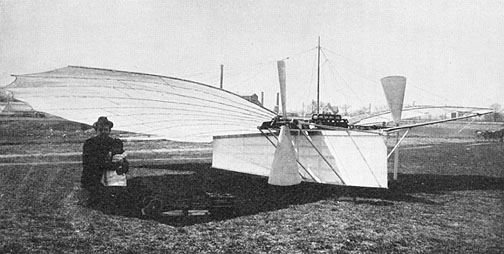
Gustave Whitehead With Daughter Rose & Whitehead #21 - ca. 1901
For half an hour the man who had demonstrated that he has a machine that can navigate the air talked of his ten minutes experience in the air ship. He was enthusiastic, spoke almost like a child who has seen for the first time something new and is panting out of breath in an effort to tell it to his mother.
Thus did Whitehead describe his sensations from the moment the air ship left the ground until she landed again:
"I never felt such a strange sensation as when the machine first left the ground and started on her flight. I heard nothing but the rumbling of the engine and the flapping of the big wings. I don’t think I saw anything during the first two minutes of the flight, for I was so excited with the sensations I experienced. When the ship had reached a height of about forty or fifty feet I began to wonder how much higher it would go. But just about that time I observed that she was sailing along easily and not raising any higher. I felt easier, for I still had a felling of doubt about what was waiting for me further on I began now to feel that I was safe and all that it would be necessary for me to do to keep from falling was to keep my head and not make any mistakes with the machinery. I never felt such a spirit of freedom as I did during the ten minutes that I was soaring up above my fellow beings in a thing that my own brain had evolved. It was a sweet experience. It made me feel that I was far ahead of my brothers for I could fly like a bird, and they must still walk.
"And while my brain was whirling with these new sensations of delight I saw ahead a clump of trees that the machine was pointed straight for. I knew that I must in some way steer around those trees or raise above them. I was a hundred yards distant from them and I knew that I could not clear them by raising higher, and also that I had no means of steering around them by using the machinery. Then like a flash a plan to escape the trees came to mind. I had watched the birds when turned out of a straight course to avoid something ahead. They changed their bodies from a horizontal plane to one slightly diagonal to the horizontal. To turn to the left the bird would lower its left wing or side of its body. The machine ought to obey the same principle and when within about fifty yards of the clump of trees I shifted my weight to the left side of the machine. It swung over a little and began to turn from the straight course. And we sailed around the trees as easy as it was to sail straight ahead.
"This gave me more confidence and I tried steering the machine to the right by shifting my weight to the right past the center of equilibrium. The machine responded to the slightest shifting of weight. It was most sensitive.
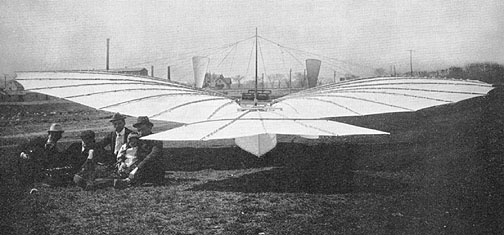
Gustave Whitehead With Daughter Rose, Others & Whitehead #21 (rear view) - ca. 1901
"I had soared through the air now for half a mile and not far ahead the long field ended with a piece of woods. When within a hundred yards of the woods I shut off the power and then began to feel a little nervous about how the machine would act in settling to the ground, for so many flying machines have shown a tendency to fall either on the front or hind end and such a fall means broken bones for the operator. My machine began to settle evenly and I alighted on the ground with scarcely a jar. And not a thing was broken.
"That was the happiest moment of my life for I had demonstrated that the machine I have worked on for so many years would do what I claimed for it, It was a grand sensation to be flying through the air. There is nothing like it." But while Mr. Whitehead has demonstrated that his machine will fly he does not pretend that it can be made a commercial success. On the other hand inventor Custead claims that his airship can be made a commercial success for it differs from Whiteheads in that it rises from the ground vertically while Whiteheads machine must have a running start like a goose before leaving the ground for the flight. Custead claims to have the most feasible form of airship but he lacks a generator that is sufficiently light and do the work required to propel the airship. Whiteheads however has the generator and by the combination of Custead’s airship and Whiteheads generator it is believed by the inventors that will be able to perfect a machine that will come nearer to the point of success than any other machine thus far made.
This new generator of Whiteheads promises great things if the claims of the inventor are fulfilled. The power is developed by a series of rapid gas explosions from calcium carbide. At the present time the spark explosions are not very rapid but Whitehead claims that he can produce 150 explosions to the minute if required. The gas thus generated is forced into a chamber where it comes into contact with a chemical preparation the ingredients of which are known only to Whitehead. The contact of the gas with the chemicals produces an enormous and even piston pressure. It is said that dynamite is nothing compared with this new power. Whitehead has had the chemists inspect his chemical preparation and they marvel at it’s power. The chemists call the chemical preparation a "queer mixture" but not one of them denies that Whitehead has discovered something valuable.
The only demonstration of the new generator’s commercial value has been in its use in the flying machine. There is no doubt that Whitehead used this generator to propel the flying machine along the ground on its wheels and also for the power for the engine that makes the propellers go when flying through
the air.
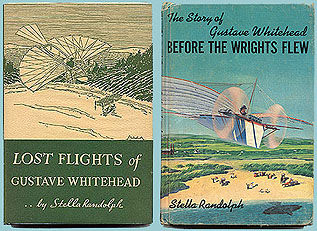
(Left) Cover Of The 1937 Book Which Sought To Establish That Gustave Whitehead First Flew In 1901 (Right) Cover Of The 1966 Book Which Added Some New Material To The Whitehead Story
The one great drawback is procuring motive power to run an airship has been the great weight required in a generator and engine. Mr. Whitehead claims that his motor will decrease by seventy five per cent the weight of any motor at present in use. The complete motive power including generator and engine will weigh about five pounds to the horse power. For a ten horse power generator twenty pounds of carbide are required to run twenty hours.
Thus far the longest time a flying machine has been able to fly has been thirty minutes.
Whitehead’s flying machine is sixteen feet long and its general appearance is that of a huge bat. From each side of the body there are wings made of bamboo poles and covered with muslin. These wings are thirty six feet from tip to tip. There is also a tail in the stern of the machine which is intended to regulate the accent and decent of the ship. There are two engines, one of ten horse power to run the machine on the wheels along the ground and the other, of twenty horse power, used to work the propellers in flying. The ten horse power engine weighs twenty-two pounds and the twenty horse engine weighs thirty five pounds.
Mr. Whitehead and Mr. Custead have formed a company for the purpose of building an air ship. Mr. Custead is backed by a company of Southern gentleman with unlimited capital and they firmly believe in the commercial success of Custead’s invention when a proper power can be found to run the machine.Mr. Custead’s airship is in Waco, Texas where its inventor originally lived.
He is now in New York. The work on the new generator which Whitehead is to supply is progressing rapidly. Whitehead has applied for patents to fully protect it and expects no difficulty in receiving them as his generator is unlike any that have been patented.
It is probable that the generators will be manufactured in Bridgeport where every facility is at hand for the manufacture of such articles.
